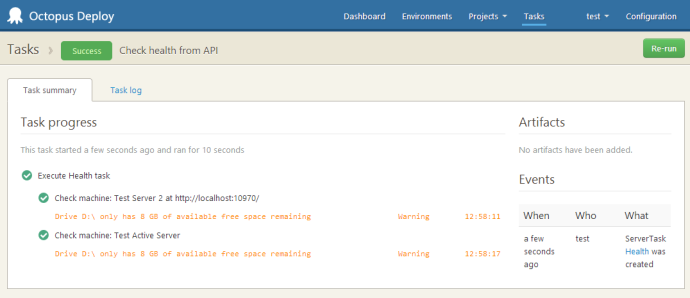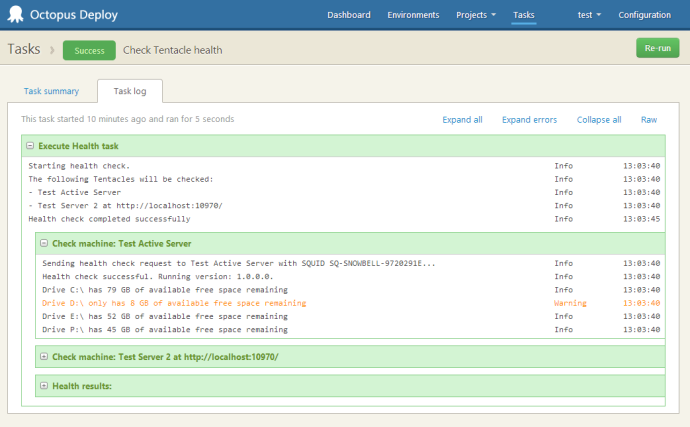Thursday, November 07, 2013
Opserver – Stack Exchange’s open source .NET monitoring system
"This is a repository to keep your eye on. I can easily see it become the devops dashboard of choice for .NET environments."
Just spotted Opserver – Stack Exchange’s open source .NET monitoring system | Joe's Code:
Wednesday, November 06, 2013
Every upgrade of iTunes on windows I need to fix sqlite3 error
First the error is "The procedure entry point sqlite3_wal_checkpoint could not be located in the dynamic link library SQLite3.dll."
And the fix: Hummie's World of Digital Scrapbooking Tutorials: iTunes sqlite3 dll error - How to Fix
Create a Virtual Tape Library Using the AWS Storage Gateway
The AWS Storage Gateway connects an on-premises software appliance with cloud-based storage to integrate your on-premises IT environment with the AWS storage infrastructure.
Once installed and configured, each Gateway presents itself as one or more iSCSI storage volumes. Each volume can be configured to be Gateway-Cached (primary data stored in Amazon S3 and cached in the Gateway) or Gateway-Stored (primary data stored on the Gateway and backed up to Amazon S3 in asynchronous fashion).
Roll the Tape
Today we are making the Storage Gateway even more flexible. You can now configure a Storage Gateway as a Virtual Tape Library (VTL), with up to 10 virtual tape drives per Gateway. Each virtual tape drive responds to the SCSI command set, so your existing on-premises backup applications (either disk-to-tape or disk-to-disk-to-tape) will work without modification.
Virtual tapes in the Virtual Tape Library will be stored in Amazon S3, with 99.999999999% durability. Each Gateway can manage up to 1,500 virtual tapes or a total of 150 TB of storage in its Virtual Tape Library.
Virtual tapes in the Virtual Tape Library can be mounted to a tape drive and become accessible in a matter of seconds.
For long term, archival storage Virtual Tape Libraries are integrated with a Virtual Tape Shelf (VTS). Virtual tapes on the Virtual Tape Shelf will be stored in Amazon Glacier, with the same durability, but at a lower price per gigabyte and a longer retrieval time (about 24 hours). You can easily move your virtual tapes to your Virtual Tape Shelf, by simply ejecting them from the Virtual Tape Library using your backup application.
The virtual tapes are stored in a secure and durable manner. Amazon S3 and Amazon Glacier both make use of multiple storage facilities, and were designed to maintain durability even if two separate storage facilities fail simultaneously. Data moving from your Gateway to and from the AWS cloud is encrypted using SSL; data stored in S3 and Glacier is encrypted using 256-bit AES.
Farewell to Tapes and Tape Drives
As you should be able to tell from my description above, the Storage Gateway, when configured as a Virtual Tape Library, is a complete, plug-in replacement for your existing physical tape infrastructure. You no longer have to worry about provisioning, maintaining, or upgrading tape drives or tape robots. You don't have to initiate lengthy migration projects every couple of years, and you don't need to mount and scan old tapes to verify the integrity of the data. You can also forget about all of the hassles of offsite storage and retrieval!
In short, all of the headaches inherent in dealing with cantankerous mechanical devices with scads of moving parts simply vanish when you switch to a virtual tape environment. What's more, so does the capital expenditure. You pay for what you use, rather than what you own.
Looks Like Tape, Tastes Like Cloud
Here's a diagram to help you understand the Gateway-VTL concept. Your backup applications believe that they are writing to actual magnetic tapes. In actuality, they are writing data to the Storage Gateway, where it is uploaded to the AWS cloud:

Getting Started
The Gateway takes the form of a virtual machine image that you run on-premises on a VMWare or Hyper-V host. The Storage Gateway User Guide will walk you through the process of installing the image, configuring the local storage, and activating your Gateway using the AWS Management Console:
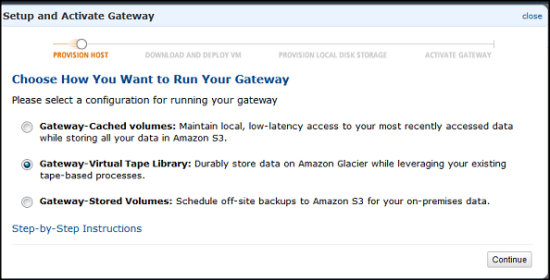
As part of the activation process, you will specify the type of medium changer and tape drive exposed by the Gateway:
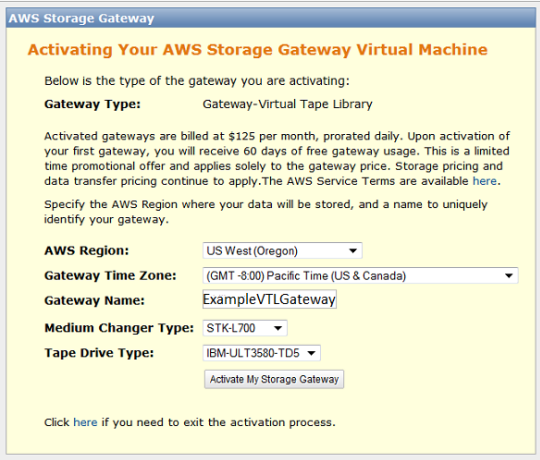
You will need to locate the Virtual Tape Drives in order to use them for backup. The details vary by operating system and backup tool. Here's what the discovery process looks like from the Microsoft iSCSI Initiator running on the system that you use to create backups:
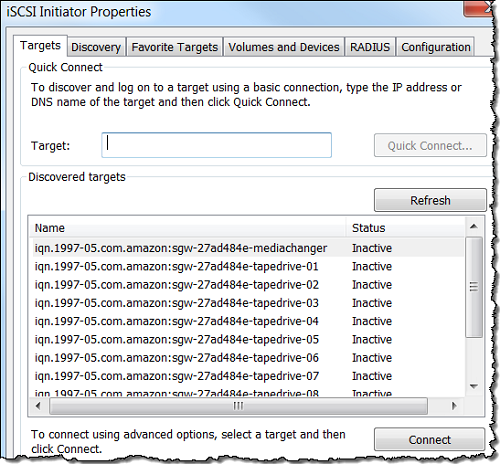
Then you create some virtual tapes:
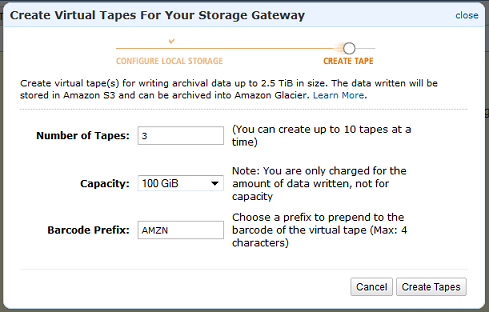
Backing Up and Managing Tapes
Once you locate the tape drives and tell your backup applications to use them, you can initiate your offsite backup process. You can find your Virtual Tapes in the AWS Management Console:
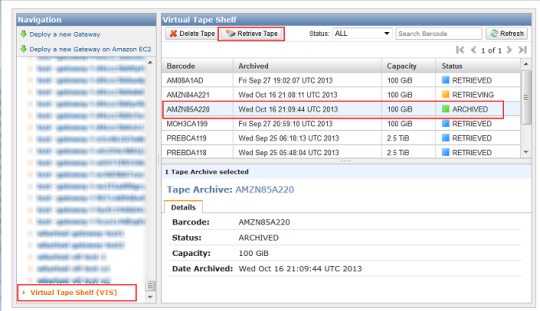
As you can see, the console provides you with a single, integrated view of all of your Virtual Tapes whether they are in the Virtual Tape Library and immediately accessible, or on the Virtual Tape Shelf, and accessible in about 24 hours.
Gateway in the Cloud
The Storage Gateway is also available as an Amazon EC2 AMI and you can launch it from the AWS Marketplace. There are several different use cases for this:
Perhaps you have migrated (or about to migrate) some on-premises applications to the AWS cloud. You can maintain your existing backup regimen and you can stick with tools that are familiar to you by using a cloud-based Gateway.
You can also use a cloud-based Gateway for Disaster Recovery. You can launch the Gateway and some EC2 instances, and bring your application back to life in the cloud. Take a look at our Disaster Recovery page to learn more about how to implement this scenario using AWS.
Speaking of Disaster Recovery, you can also use a cloud-based Gateway to make sure that you can successfully recover from an incident. You can make sure that your backups contain the desired data, and you can verify your approach to restoring the data and loading it into a test database.
Bottom Line
The AWS Storage Gateway is available in multiple AWS Regions and you can start using it today. Here's what it will cost you:
- Each activated gateway costs $125 per month, with a 60-day free trial.
- There's no charge for data transfer from your location up to AWS.
- Virtual Tapes stored in Amazon S3 cost $0.095 (less than a dime) per gigabyte per month of storage. You pay for the storage that you use, and not for any "blank tape" (so to speak).
- Virtual Tapes stored in Amazon Glacier cost $0.01 (a penny) per gigabyte per month of storage. Again, you pay for what you use.
- Retrieving data from a Virtual Tape Shelf costs $0.30 per gigabyte. If the tapes that you delete from the Virtual Tape Shelf are less than 90 days old, there is an additional, pro-rated charge of $0.03 per gigabyte.
These prices are valid in the US East (Northern Virginia) Region. Check the Storage Gateway Pricing page for costs in other Regions.
-- Jeff;
Monday, September 02, 2013
Whip Up Awesome w/the Chef Infrastructure Automation Cookbook [feedly]
The Chef Community and its many awesome contributors keep doing amazing things. Case in point, our friend Matthias Marschall (a software engineer 'made in Germany' and CTO at gutefrage.net GmbH helping run Germany's biggest Q&A site) just published his new book "Chef Infrastructure Automation Cookbook".
Check out the synopsis:
Chef Infrastructure Automation Cookbook has all the required recipes to configure, deploy, and scale your servers and applications, irrespective of whether you manage 5 servers, 5,000 servers, or 500,000 servers.
Chef Infrastructure Automation Cookbook is a collection of easy-to-follow, step-by-step recipes showing you how to solve real-world automation challenges. Learn techniques from the pros and make sure you get your infrastructure automation project right the first time.
Available here, it's a dynamite Chef resource created by one of us in the Community. Chef has always been about a group of like-minded practitioners working together to help each other build better infrastructure and Matthias' new book keeps that tradition going strong.
Whether you're new to Chef or a long-time user, Matthias has something to teach all of us. All of us here at Opscode thank Matthias for the Herculean effort he put into this project and hope all of you in the Community benefit from what he's created.
Wednesday, August 28, 2013
Achievement Unlocked - Opscode Learn Chef Tutorial Followed
Saturday, August 24, 2013
DevOps side project - chef v puppet + vagrant + aws
Friday, August 23, 2013
Wallet really empty now!
Creating Calca - A symbolic calculator with markdown for iOS and more [feedly]
Octopus 2.0: Health checks will now check for free disk space [feedly]
Hard disks are cheap, but running out of free space is a common problem when it comes to managing application servers, especially virtual servers. Octopus isn't meant to replace Nagios or other health monitoring tools, but we do have a basic health check that we run every 30 minutes against your servers. A good suggestion came up on UserVoice: report free disk space in the health check.
This is the health check summary in Octopus 2.0:
Clicking through, you can see the details for all the fixed disks:
As I said, this feature isn't meant to replace your existing server monitoring tools, but if you don't already have something in place, hopefully it's useful. Happy deployments!
Thursday, August 22, 2013
Achievement unlocked : iOS and Mac developer program joined
Writing code can be expensive on the Apple Eco system. lets hope this becomes a good investment!
Well it's the reason I bought the Mac in the first place so it's about time I get something in the App Store.
The big change in Bootstrap 3 that no one’s talking about [feedly]
As you probably already know if you've seen any tech news this week, Twitter Bootstrap 3 came out of RC and was officially released this past Monday. There are a plethora of changes in the new version, but the two most visible changes are a "mobile first" responsive grid and a new flat graphical style, ala Windows 8.
The flat styling has been especially controversial. If you didn't need to differentiate a site with distinctive design (e.g. internal admin sites), you could usually get away with using previous versions of Bootstrap without any stylistic modification, but not so much with Bootstrap 3.
Unfortunately for those uses, the default styling in Bootstrap 3 is fairly bland until you customize it a bit or augment it with a full theme. Bootswatch and WrapBootstrap are two great resources to accomplish the latter. To simply bring Bootstrap 3 most of the way back to Bootstrap 2.3.2′s look and feel, there's also an official theme you can apply.
So, I think the brouhaha over flat vs. gradient defaults is overblown. More importantly, that change has had an interesting side-effect that seems to have been mostly overlooked this week: Performance.
"Mobile first" means performance is crucial
In a "mobile first" world, Bootstrap's biggest weakness has always been performance. It's surprising if you haven't delved into the topic before, but the impact of structural choices in a CSS framework can have a tremendous impact on layout and rendering performance – particularly on under-powered mobile devices. Even between pages that look nearly identical, small differences can make or break achieving the all-important 60 FPS draw rate for scrolling and animation.
Adobe's relatively bare-bones Topcoat framework is a great example of just how much performance you can squeeze out of a mobile browser when that's your primary focus. They even have a running benchmark of each build's rendering and layout times as part of their CI workflow. Compared to less-optimized frameworks, the difference in jank is stark on slower devices and/or browsers.
Coming back to Bootstrap 3, what hasn't been discussed very much this week is that the new release has had a significant impact on rendering performance. To illustrate that, Paul Irish used Chrome's dev tools to took a look at the performance difference between Bootstrap 2.3.2 and Bootstrap 3 RC1 a few weeks ago:
Pretty impressive.
In Bootstrap 3′s case, it's likely that the improvement stems almost entirely from the flat styling, as gradients and shadows are expensive to render. Regardless of the root cause, Bootstrap 3 is much more viable for sites that need to work well on under-powered mobile and tablet devices.
You've been reading The big change in Bootstrap 3 that no one's talking about, originally posted at Encosia. I hope you enjoyed it, and thanks for reading.
If you've got any feedback, please click through and leave a comment; I'd love to hear from you. You can click here to jump directly to the comment section of this post.
Related posts:
How to Be a Highly Productive Night Owl [feedly]

Being an early riser has its benefits, but it isn't for everyone. Some of humanity's greatest minds (Voltaire for example) were renowned for sleeping in. Depending on personality, environment, and work schedule, being an early riser may not be practical.
Tuesday, August 20, 2013
Achievement unlocked - node.js, yeoman, bower, grunt, ruby and compass installed
Achievement unlocked - Xamarin Studio MVC4 Razor app with ServiceStack API and Ember.js
Octopus Deploy in the ThoughtWorks Technology Radar [feedly]
So while I use Octopus Deploy and TeamCity for continuous delivery for windows based software, I am now starting to look at chef, puppet and vagrant for deploying non windows stack technology.
I'm a bit late in posting, but Octopus Deploy earned a spot in the Thoughtworks Technology Radar last May:
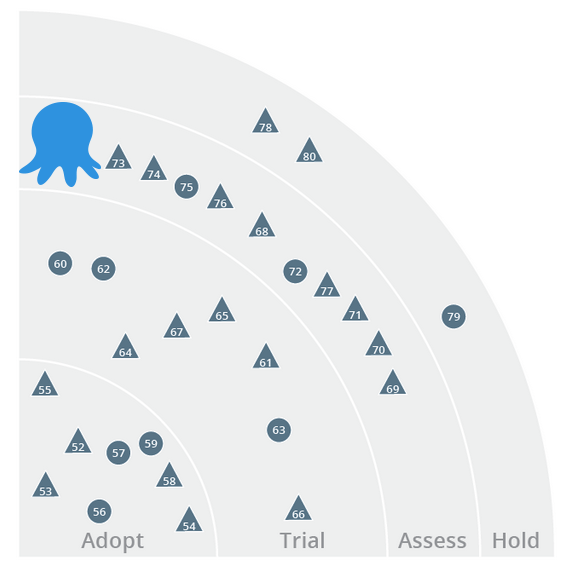
What is the Technology Radar?
The ThoughtWorks Technology Advisory Board, a group of senior technology leaders in ThoughtWorks, creates the radar. They meet regularly to discuss the global technology strategy for ThoughtWorks and the technology trends that significantly impact our industry. The radar captures the output of the Technology Advisory Board's discussions in a format that provides value to a wide range of stakeholders, from CIOs to developers.
Octopus was listed in the Assess category, which means:
Assess: Worth exploring with the goal of understanding how it will affect your enterprise.
Which I think is fair given how new automated deployment solutions are in the .NET ecosystem. What I found interesting is that products like Microsoft's Team Foundation Server are listed in the "Hold" category.
From the PDF:
Windows infrastructure automation should be adopted, however it still remains more difficult than automation on a Unix platform. Tools like Chef and Puppet are increasing their support, but there are also Windows specific solutions being developed like Octopus. Octopus allows automated deployment of your ASP.NET applications and Windows services and decreases dependency on PowerShell. It can be used with both NuGet using Octopak and TeamCity to create a full build, package, and deployment pipeline.
Friday, August 16, 2013
Amazon Web Services launches mobile push notifications [feedly]

Amazon Web Services reinforces its mobile presence by launching Simple Notification Service (SNS), allowing developers to push and manage notifications to Apple iOS and Android devices from a single API.
The real innovation here is the ability to develop push notifications for multiple platforms via one single API. Before Simple Notification Service, push notifications on the main mobile platforms were sent by OS-specific services built into the apps themselves. This is because Apple, Google and Amazon use different relay services to push their notifications on their own platforms.
Developers had to integrate these specific relay-services on each platform to answer to their customers' needs. This way of doing things was time and cost consuming.
Amazon just provided an answer to an important bottleneck for mobile developers today: having to integrate push notifications multiple times depending on the platform used. Moreover, SNS can also be helpful for the daily-basis push notification management. Before SNS, developers had to manage each platform separately in order to send a new notification. This operation was laborious. Now, mobile developers can push notifications on iOS, Android and Amazon from a single API.
Furthermore, the cost of this service is very attractive for mobile developers: Amazon has indicated SNS can be used to send up to one million notifications per month without incurring any cost. Over a million notifications, it costs $1.00 to send one million mobile notifications (every million messages published costs $.50, and $.50 for every million messages delivered). Compare this with popular push notification provider Urban Airship, which pushes the first million messages free but charges $0.001 per message afterwards (or $1,000 per million).
Amazon's SNS supports the most popular mobile operating systems with Android and iOS, but what about Windows Phone? Nothing has been said for now about the mobile OS developed by the Redmond-based company. However, it's very likely that Amazon releases an update in the next months to integrate this OS as it still represents 3% of the worldwide smartphone market share.
The post Amazon Web Services launches mobile push notifications appeared first on .
Tuesday, August 06, 2013
A Survey of the Localhost Proxying Landscape [feedly]

In late 2009, soon after coining the term 'webhooks' and starting to evangelize them to the world, Jeff Lindsay ran into a problem.
I had another idea while thinking about webhooks. It would be great if I could expose a local web server to the Internet with a friendly URL. It should just be a simple command. There would have to be a server, but there could just be a public server that you didn't even have to think about.
Jeff's idea grew into localtunnel, a friendly wrapper around an SSH reverse tunnel that makes your localhost available via a public URL. The first time I used it, it felt like magic. It completely changed the nature of working with webhooks. I was, well, hooked.
What was novel at the time has grown into a little bit of a cottage industry amongst API tool makers. Many similar services have cropped up, specializing in different versions of the same problem. Here's an overview of all the services I know of.
localtunnel
The original. The initial SSH-based version with the Ruby client eventually ran into some issues. Ruby and SSH are also a bit precocious on Windows. Jeff released a beta of a new version 2 with a Python client and a new wire format. If you're using localtunnel now, that's the route you'll want to go. localtunnel is free and community supported.
Forward (formerly Showoff)
Forward was another early entrant, focusing more on allowing developers to show off web sites they were working on from their local machine. In early 2011 they rebranded from Showoff to Forward. They offer a few different pricing plans for various needs.
ProxyLocal
Another Ruby based solution, ProxyLocal was started in late 2010 and was last updated a year ago, though the web service seems to be operating still. It distinguishes itself from localtunnel by letting you choose the subdomain for your public URL. The service is free.
PageKite
PageKite is another commercial service started around the same time independently of the others (this comment suggests localtunnel predated it by only a few months). PageKite is Python-based, offers end-to-end encryption and can tunnel protocols other than HTTP. Here's a post comparing it to Showoff. They offer subscriptions, pay-what-you-want and a free plan for OSS devs.
Ultrahook
Ultrahook is a new entrant to the scene, focusing on webhook debugging. Created by Vinay Sahni from SupportFu, Ultrahook consists of a client distributed via Ruby gem. The service is free, but the source is not available. By signing up for a free account you'll receive an API key that "gives you a exclusive namespace. All endpoints you create will be subdomains under your own namespace. This ensures that you can always reconnect to the same endpoints at some point in the future."
ngrok
The latest entrant is ngrok from Alan Shreve (formerly of Twilio). ngrok is written in Go (both client and server) and has, by far, the easiest client installation options with single-file executables for Windows, OS X and Linux. No more fighting with Ruby gems Windows users! In additional ngrok adds an introspection layer so you can see the traffic that was passed back and forth over the tunnel. ngrok supports SSL, password-protected tunnels, reserved subdomains and support for TCP/UDP tunneling. It's free and the source is on GitHub.
Runscope Passageway
My company Runscope also offers a version of localtunnel called Passageway. We've added tight integration with the Runscope API traffic inspector, end-to-end encryption and permanent URLs but otherwise, it's just localtunnel (a project we're proud to sponsor). Passageway is currently in public preview and included with any Starter or Team plan.
My recommendation
If you're just getting started, I highly recommend ngrok (yes, even over our own product). Client set up is the easiest and it offers the most features of any of the options and its completely free. Go tell Alan how awesome he is on Twitter to thank him for such a great service.
Did I miss any? If so, let me know in the comments.
Photo courtesy of Tina Carlson
Build Google Chrome Extensions in Visual Studio [feedly]
A little while back, Sayed Hashimi and I built the Web Developer Checklist Chrome extension as a companion for the website webdevchecklist.com. We built the extension in Visual Studio and quickly realized that we could optimize the development experience substantially by tweaking the build process along with other details.
From that experience, we now have a project template that contains all you need for writing a Chrome extension and it is available for download.
The project template gives you the following features:
- JavaScript Intellisense for the Google Chrome object model
- Folder structure suited for production ready Google Chrome extensions
- MSBuild integration to produce .zip files to upload to the Google Web Store
It's all explained in this short demo video.
As always, this project template is open source on GitHub.
Download the Visual Studio project template
Here's a Channel9 video where Sayed explains how he modified the build system for this template if you're interested. It starts around 13 minutes in.* $4.95/month ASP.NET Hosting with FREE SQL 2012 DB! – Click Here!
Monday, August 05, 2013
The World’s Simplest HTML5 WYSISYG Inline Editor [feedly]
All it takes is
contenteditable, execCommand, and 14 lines of JavaScript. (The demo uses Bootstrap and jQuery, but they can easily be done without.)℅ @chriscoyier
Why Chromecast is no replacement for Apple TV...yet! [feedly]
The main reason for me is I cannot get hold of one for that price in the UK.

Google Chromecast might well be an exciting new product, and it might well only cost $35, but there's still some inherent let downs and frustrations for early adopters. Particularly it seems, streaming live YouTube events to your Google dongle is a no-go area right now. Android Central Forums member danrad55 writes:
I was looking for some help "Chromecasting" the LIVE Lollapalooza Concert from Chicago with my new Google Chromecast via Youtube as promised, but no luck. Yesterday it wouldn't play so I thought that because it was new, they were having some start up issues. Today the concert plays better but no Chromecast. Anyone else have the same issue? It plays other feeds, Netflix beautifully. I decided to plug in my Apple TV and try streaming using my iPad 2. Perfect. I have tried using my PC and Samsung S4 to no avail. Bummed and disappointed and sadly, I have to admit that at this point the Apple System is kicking ass. Anyone here know how to stream the Live feed. Thanks in advance.
We're not ripping on the Chromecast here, because truth told, we're excited to see what it brings to the table in the coming months. But, YouTube is a Google product, and it seems in some aspects it isn't working well with other Google products. Yet in strolls the Apple TV and AirPlay to rescue danrad55 in his hour of need. Sure, licensing and such may well be an issue, but it's still good to see that the Apple TV is packing where and when it matters.
So, have any of you guys taken the plunge with Chromecast yet, and if so, have you encountered any early frustrations? Be sure to drop us a line in the comments, and with your Mobile Nations Passport, jump into the discussion in the Android Central Forums!
Source: Android Central
The app55 API: Turning Britain, and the World, into a Nation of E-Shopkeepers [feedly]
Mobile payments used to be difficult difficult lemon difficult.
 The app55 API lets online and bricks and mortar merchants in the UK take payments from customers on any device, on websites designed and controlled by the retailer. app55 joins 362 payment APIs in our directory. In addition to offering one click, being fully brandable (meaning the customer sees your site only, and is not aware of app55's role), all of the stiff PCI compliance issues that make handling these transactions so complex is outsourced through them.
The app55 API lets online and bricks and mortar merchants in the UK take payments from customers on any device, on websites designed and controlled by the retailer. app55 joins 362 payment APIs in our directory. In addition to offering one click, being fully brandable (meaning the customer sees your site only, and is not aware of app55's role), all of the stiff PCI compliance issues that make handling these transactions so complex is outsourced through them.
The crucial compliance issue, of course, is to avoid capturing an storing the end user's credit card data. That's a tough nut to crack, to use the data in order to charge the card without actually holding onto that data, a task made easy by involving third parties aimed at handling this issue. Adding firewalls, an intrusion detection system, and many other security features bullet-proofs the operation.
The documentation on this RESTful API (responses in JSON/JSONP with authentication via an API key) offers a tutorial on four steps needed to implement the API. First you need to create the payment form in HTML, then initialize the app55 JavaScript library, cerate and submit the form and send the returned transaction ID to your servers. But this can all be accomplished with a few lines of code.
Merchants seem to like it, if Dafydd Thomas, Head of Consumer Strategy at Remploy is any indication,
"The company looked at a number of different solutions but selected App55 because it offers a secure, one-click checkout for customers while suppliers can be integrated quickly and are paid immediately."
app55 is aiming at a broad market, from the largest companies in Britain all the way down to the mom and pop shops. And it appears that its addressable market may be much bigger than just Britain. Despite have both offices located in the UK, app55 does "accept payments in all major currencies and countries with multi-channel and multi-device capability."
Related ProgrammableWeb Resources
5 questions to ask yourself before starting a company blog [feedly]
 With so many blogging platforms, plugins and options available to businesses these days, starting a company blog really couldn't be easier.
With so many blogging platforms, plugins and options available to businesses these days, starting a company blog really couldn't be easier.
Well, easier in terms of being very accessible and quick to set up. But starting the company blog itself is really the easiest part. It is continually creating fresh, relevant content, getting support from colleagues and ensuring your blog reaches your desired audience that is more of a challenge.
Before you undertake the task of business blogging, it is important to make sure you and your team are aware of what you're letting yourself in for. So consider the answers to these 5 important questions, to get the most from your company blog and make sure you're are up to the challenge.
1. Who will be blogging?
Will you be the sole contributor to your company blog? Or will you get others involved? Collaborative blogging is the easiest way to create fresh, interesting posts on a regular basis, but this does require getting your colleagues on board at a very early stage.
When starting a company blog, it is important that everybody knows from the offset what will be required of them. Will everybody contribute ideas, which you will then turn into blog posts? Or will the burden of writing be shared? How much will each individual contribute? Will you outsource to content writers if you don't have time? Or consider getting a guest blogger to post?
(You can read our post about how to make the most from you team when blogging here).
2. Who is your reader?
Identifying your target audience is essential. Who do you want to reach with your blog?
Of course, your business will be probably already have some idea of its target customers (or it should), but starting a company blog requires you to take this even further. You need to think not just about your current audience who may consider buying or using your company's products or services, but anyone who could read your blog and gain value from it – and become a potential customer in the future.
Consider everything your target audience might be interested in reading about. What are their pain points? What might they need help with? Aim to help, guide, inform, educate and entertainment them.
3. What will you blog about?
Starting a company blog is a great way to showcase your industry expertise, and establish your business as the go-to people for whatever it is you do. But as with all content marketing, your company blog can't be all about you. What are the general needs and interests of your audience outside your immediate products and services? What areas will your blog cover?
As well as this, the fact that there are so many blogs out there fighting for attention means it is good for your blog to have a unique subject matter or specific style. Will your blog have a niche? Why should people read your blog over your competitors? What kind of writing style and tone will you use? How will your brand's core values be displayed through your blog?
4. Which blogging platform will you choose?
This depends somewhat on your own experience. Many blogging platforms such as WordPress and Blogger offer a great variety of plugins and customization options, but require a significant amount of specialist knowledge. Others such as Tumblr or Passle are much easier to use, and allow you to get set up quickly. Which blogging platform is right for your business, based on your own needs and experience?
(You can read our post about some of the lesser known blogging platforms you might consider here.)
5. How much time will you set aside for blogging?
One of the main reasons company blogs fail is because of a lack of commitment. Business blogging is hard, and in order to have a sustainable blog that is updated frequently, you will need to put in a significant amount of time per week. The most important question to ask yourself: are you prepared to put in the time and effort to make it work?
Before starting a company blog, you'll need to decide how many hours a week you will set aside to blogging – researching for ideas, writing and editing posts, responding to comments and promoting your blog. Unless you are committed, your company blog will quickly end up stagnant and outdated, leaving a poor impression on both current and potential clients and customers.
Of course, this list is by no means definitive. But it hopefully should give you some idea of the things you need to think about before starting a company blog, in order to give you the best chance of success.
| Tweet |
The post 5 questions to ask yourself before starting a company blog appeared first on passle – free research, content marketing and business blogging tool.
The one key component of all great blog posts [feedly]
We've written a few articles recently about snackable content and micro-blogging, and how you don't always need to be writing long articles anymore. Content marketing is changing, reflecting the changing ways we find, take in and engage with information.
Because of this, business blogging is changing too. Creating great blog posts on a regular basis no longer needs to the immense challenge that it once was. So what do you need to be doing? And more importantly…
What are the essential components of great blog posts?
There are many articles out there on blogging strategy, the different types of blogs you can create, and the key components of great blog posts. And let's be honest, a lot of their suggestions go without saying…
Create a catchy title
You need to draw your readers in, and create content that they will want to click on and read.
Structure and format
Make you blog post as easy to read and visually appealing as possible. Lists, bullet points and subheadings always work well.
Include images and videos
The more visual you content, the more engaging it is for readers.
Optimise for SEO
Target related keywords, include links and meta tags to give your blog posts the best chance of ranking highly on search engines
But surely these points are already fairly obvious?!
They have been propounded a million times before, and are probably things you do already when trying to create great blog posts.
I believe there is one key component to business blogging – or any kind of blogging – which is fundamental to all content marketing, now and in the future:
Adding value
Marketing is – and always will be – primarily about people. Which is why there has to be a purpose to your content.
Great blog posts need to be human-centric, something that people will read and genuinely take benefit from – not just a "tactic" employed to increase web traffic and build up your total number of webpages. Keywords and SEO are of course important, but they are far secondary to providing content of value to your audience.
Easier said than done, you might well argue. How can you add significant value through your company blog, but still manage to create great blog posts on a regular basis? We've all heard the expression "quality over quantity", but anything you read on the topic of business blogging will still tell you how important frequency is.
Our answer is that you don't need to be writing full blown articles every week.
Now that IS a challenge. You can still create great blog posts which add value, in just a few sentences. This can be done through:
• Providing your own point of view on a current issue or news story
• Sharing and commenting on an infographic
• Discussing insightful new statistics and what these mean for your industry
• Quoting an industry professional and discussing their point of view
• Sharing a video and giving your own thoughts on it
• Bringing together several ideas or recent events, and observing an underlying trend
• Giving a different or new opinion on a well-covered topic
There is no point just adding to the masses and masses of content being produced every minute for the sake of "content marketing". Just a few lines on something of genuine interest to your audience is far more valuable than 600 meaningless words on a topic that has been covered 100 times before.
Not convinced? Just look at our Content Marketing and Business Blogging feeds to see how this can be done.
| Tweet |
The post The one key component of all great blog posts appeared first on passle – free research, content marketing and business blogging tool.
a content marketing dilemma: why produce content when there’s so much already out there? [feedly]
So you're a small business owner. Maybe you oversee the marketing yourself, or get somebody else to. Either way, you've no doubt read a bit about content marketing, and how it's going to be – or indeed, already is – the next big thing.
(If not, you only need to look at Google Trends to see the growth in popularity of "content marketing" as a search term to understand how it has taken off in the last 2 years.)
Absolutely everything and everyone is telling you to produce content. So you think you probably should give it a go.
Yet despite the masses of information on the unavoidable reality of content marketing today, you may still be unconvinced. You may be thinking…
• Why does anyone care about what I write?
• How will I think of interesting things to write about?
• How are people going to find my content anyway?
• Will the content I produce be interesting enough for people to read?
• Will it make a difference to my revenues?
• Will it be worth the time and effort?
And crucially, our content marketing dilemma for today:
• If everybody's doing it, there must be so much out there already. Why should I add my worthless thoughts to the reams and reams of content that already exists?
So, why produce content?
You think producing content will be worthless when there is loads of great content out there already.
This is where you are wrong.
Velocity Partners made a great SlideShare presentation entitled Crap: The Content Marketing Deluge. And as its name might suggest, because of how quickly content marketing has taken off (leading to a significant skills gap), a lot of the masses of content now being produced is pretty rubbish. People are only doing content marketing because they think they should. And consequently, many are failing.
In our recent survey of 525 businesses, only 1 in 8 were able to maintain an active blog. And 63% of businesses surveyed have absolutely no online presence (blog, company news page that is regularly updated.*
We can't argue with the fact that everyone is talking about content marketing. Talking about doing it, spending more on it, the many benefits of it… But the reality is that many businesses still can't manage to do it well. And being one of the businesses who can will no doubt put you at a huge advantage over your competitors.
Not sure how to produce content that isn't a waste of space?
Well, there is no shortage of help available on the web. Just look at our post How to Create Content That is Perfect for Your Business for tips on creating content that is fresh, relevant and engaging. Or some of best ways to ensure you add value through your content, as The Key Component to All Great Blog Posts demonstrates.
Even if it wasn't the case that most content marketing efforts are pretty rubbish, there are still many good reasons why you should produce content on a regular basis:
• To demonstrate thought leadership and expertise
• To improve your own SEO
• To drive engagement and web traffic from sharing on social media
• To develop your brand identity and tone of voice
• To make your content even better than other, to give yourself the edge over competitors
So despite what you might think, there isn't actually loads of great content out there. And even if there was, there are still plenty of good reasons for your business to produce content anyway.
*a blog or company news page must have 3+ posts a year to be classified as "active" or "regularly updated" in our survey, a Twitter or Facebook page must have 1+ post a month.
| Tweet |
The post a content marketing dilemma: why produce content when there's so much already out there? appeared first on passle – free research, content marketing and business blogging tool.
Small Business Blogging: 8 Ways to Demonstrate Expertise Through Your Company Blog [feedly]
 Many small businesses are hesitant to start blogging, and given the effort and commitment currently required, it's no surprise why.
Many small businesses are hesitant to start blogging, and given the effort and commitment currently required, it's no surprise why.
However, there is another common reason for hesitance towards small business blogging. Business owners and marketers don't feel they are credible enough to consider themselves "experts" in their field. So question their abilities to create consistently "expert" content for their small business blog.
Am I really an expert?
The Oxford Dictionary defines an expert as:
"a person who is very knowledgeable about or skilful in a particular area"
Note the crucial part of this sentence: in a particular area.
Many small business owners and marketers would be reluctant to call themselves experts, because it implies some kind of overarching knowledge in absolutely everything even remotely related to your industry. But let's face it – nobody knows everything. If you have significant skills, knowledge and experience in one particular area (which you undoubtedly will, in virtue of running your own small business) to many, you will be considered an expert.
As Sarah Santacroce observes in her post here, perhaps the word specialist is more appropriate when referring to skills or knowledge in a particular industry:
"…if someone calls themselves a specialist, it tells me that they specialize in this topic, and have valuable knowledge and skills in this area. You don't have to know absolutely everything, because of course there's always room for improvement."
Similarly, in this post, Sean Ogle distinguishes between two ways in which you can be an expert:
- Absolute expert – who knows their skill, craft or topic inside out.
- Relative expert – who has a perceived level of credibility due to the fact they know more about their skill, topic or craft than most.
To succeed in small business blogging, being a relative expert is more than sufficient.
 Your business presumably exists because you have a particular service or product you are knowledgeable or experienced in, which you want to impart onto your customers. As such, you will undoubtedly know more about your industry than your potential customer who is coming to you.
Your business presumably exists because you have a particular service or product you are knowledgeable or experienced in, which you want to impart onto your customers. As such, you will undoubtedly know more about your industry than your potential customer who is coming to you.
As long as you are honest about your level of expertise, and don't make claims you cannot justify, then the nudging fear you are not "expert" enough for blog-writing is wrong. And should not be a reason to abstain from small business blogging.
Ways to show you are an expert through small business blogging:
A small business blog is a perfect way to demonstrate your expertise through informing, educating and engaging your leads and customers – and there are many ways in which this can be done:
1. Ask your customers questions, and answer them
Give them the knowledge and information that they are really looking for.
2. Write about common questions you receive from customers, or difficulties they are facing
Do you hear the same questions from customers day in, day out? Position yourself an authoritative thought-leader with the answers through your small business blog.
3. Create how-to guides and videos
Share your expertise through many forms of content to give yourself the edge over competitors.
4. Comment on recent industry news
Show how you have your finger on the pulse when it comes to new developments in your industry, and give your expert opinion to demonstrate your insight.
5. Write about recent general news and explain implications for your industry
Show how you and your business are switched on to relevant goings on not just in your industry, but in the news more broadly.
6. Debunk common myths and misconceptions about your industry
Use your small business blog to become a trusted source for accurate information, and distinguish yourself from less esteemed competitors in your field.
7. Be specific
If there is a niche or particularly specialist topic that really interests you or you know a lot about, share it with your followers. And prove you have more than just a surface knowledge of your industry.
8. Write about your own industry experiences
Share successes and failures, and what you have learnt from them.
With all the content being produced out there, establishing yourself as a credible authority in your industry couldn't be more important. But demonstrating your expertise through small business blogging doesn't have to be the challenge it may seem to be.
(And in fact, a simple tool like passle can make it a whole lot easier.)
| Tweet |
The post Small Business Blogging: 8 Ways to Demonstrate Expertise Through Your Company Blog appeared first on passle – free research, content marketing and business blogging tool.






